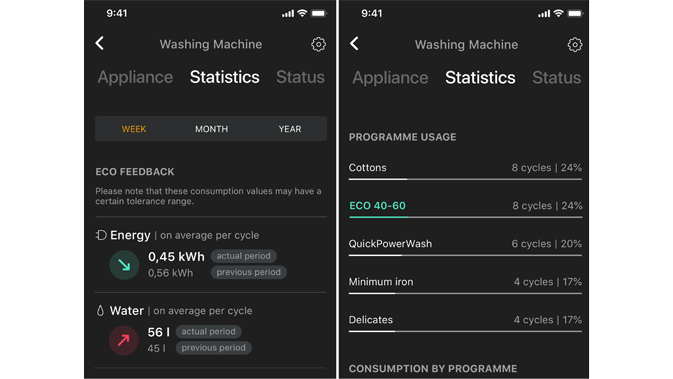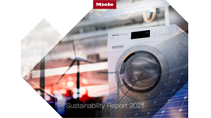Press releases
Miele makes the smart home sustainable – and reduces CO2 emissions and electricity bills

- Consumption Dashboard provides tips on the efficient use of domestic appliances
- Smappee is a new partner for the management of solar power
- Company joins forces with InterConnect to research European energy standards
Faced with the climate crisis and rocketing energy prices, the responsible use of energy is more urgently needed than ever before. For that reason, Miele supports its customers in making their machines, which are already highly efficient and feature smart functions*, even more environmentally friendly. This is facilitated by a genial Consumption Dashboard in the app, machines linked to solar technology and, not least, by Miele's involvement in an international research project.
The majority of Miele machines sport highest energy efficiency ratings and hence count among the most sparing products on the market. It is also correct to say that around 85% of an appliance's CO2 footprint is attributable to the usage phase. Through the regular use of energy-efficient programmes, customers can contribute in a major way to the climate-friendly use of their domestic appliances, whilst at the same time cutting running costs considerably.
But which programmes are particularly energy-efficient and therefore environmentally friendly? A new Consumption Dashboard in the app creates transparency in this respect and provides tips and trick on the use of dishwashers, washing machines and other appliances. This is particular helpful when washing laundry as there is a wealth of programme options to select from. The dashboard provides information on how much water and electricity has actually been used by a programme. The deeper analysis of the data is simple and concise and compares, for example, averages for all the programmes used. This reveals at a glance that the Eco 40-60 wash programme uses far less electricity compared with Cottons (40 or 60 °C). The Consumption Dashboard also shows how often a programme has been run each week, month or year. Last but not least, the total number of cycles run is listed here as, after all, operating a machine 26 instead of 30 times a month goes easier on both the wallet and the environment.
Accept shared responsibility and reduce CO2 emissions
'From behavioural data, we know that energy-saving programmes were only used in the past to a limited extent. At the same time, though, many users wish to change their behaviour and are very interested in the consumption of water and energy', says Peter Hübinger, Senior Vice President Smart Home with Miele. 'By evaluating statistics and through extremely well-presented data in our app, we are creating transparency and providing orientation. With an awareness of achievable potential savings, many more people are likely to opt in future for the more economical and more environmentally friendly programme options', says a thoroughly convinced Mr. Hübinger.
The Consumption Dashboard (in the statistics section of the app) will be launched from 2023 onwards in Germany and Australia to cover washing machines; it will be available in Q4 of this year for dishwashers. Further appliances and development stages will also follow from 2023 onwards.
New partner for the efficient use of 'home-grown' solar power
There has been a paradigm shift in the use of solar electricity. Whereas home-owners in the past were paid good money for feeding electricity into the grid, it has recently become more economical to use as much 'home-grown' electricity as possible on site. Intelligent energy management systems ensure that the figures stack up and at the same time protect the electricity grid from peaks in demand.
The new Miele partner for this type of energy management is the Belgian company Smappee. The principle: Miele domestic appliances and other smart energy-using devices start automatically when the demand for electricity is low and/or a rooftop PV array is generating a plentiful supply of energy. To this end, domestic appliances – ideally washing machines, tumble dryers and dishwashers – are switched to AutoStart mode after loading. And there's no risk that laundry or crockery will not be ready in time: Should solar generation equipment be unable to provide sufficient power, the machines automatically switch to the grid.
Smappee technology relies on a systematic, integrated approach for its smart management of buildings. It is also possible, for example, to precisely map all energy consumption, gas and water included. The company, founded in 2012, is also a well-established player on the market for charging stations for electric vehicles. Smappee has its own representation in more than a dozen countries and offers the electrical trade highly qualified training courses for technicians covering its range of products.
A similar cooperation with a focus on the integration of domestic appliances in smart energy management systems was launched in early 2022 in cooperation with Loxone, the Austrian specialist for home automation. Alongside the preconfigured systems from Smappee and Loxone, practised system integrators can also link Miele domestic appliances to other energy management platforms. In all cases, communication is via the open interface of the Miele@home system (third-party API). Benefits to Miele customers: The choice of systems is already large, and every home-owner with a PV array can contribute towards slowing down the rate of climate change by connecting their power generation system to an intelligent energy management tool.
InterConnect for future European standards in energy management
When it comes to power generation and trading, the markets in Europe are closely interlinked. However, the European continent is still far removed from common standards covering energy management as the conditions in individual member states still differ considerably. The InterConnect project initiated and funded by the European Commission vows to change this – and Miele is on board.
InterConnect aims to enable efficient and interoperable energy management and promote an approach to energy usage which takes the needs of the grid into consideration in sentient homes and in commercial premises throughout Europe. In total, 51 European companies and research institutes are participating in the project. Miele provides around 550 appliances (washing machines, dryers and dishwashers) in 7 pilot regions. One of these is Norderstedt in Schleswig-Holstein, up in the far north of Germany. The town's utility there provides an energy mix from a variety of sources with a high proportion of wind power and offers test households in the municipality flexible electricity tariffs. One objective is to make virtually full use of the fluctuating wind power supply without the need to power down wind turbines. Devices running on electricity such as domestic appliances start automatically when the grid is able to provide power in abundance. Miele is providing washing machines, dryers and dishwashers, 30 in each case, to the project in Norderstedt.
The focus in almost all pilots is to shift peaks in demand, notwithstanding the fact that framework conditions differ. In the Dutch city of Eindhoven, for instance, the project concentrates not on wind energy as a primary source of energy but on integration into a smart grid fed from a variety of energy sources. Here, Miele supplies 100 washing machines and 100 tumble dryers to a modern building complex run by a housing association.
One key requirement common to all projects is the interoperability of technical components. With respect to domestic appliances, this means that products must integrate well into a central energy management system, even when washing machines, dryers and dishwashers are from different brands. 'This is one of the central conditions for complex smart home applications being accepted by consumers', says Peter Hübinger, 'that's why Miele is supporting the development of common standards as a matter of urgency'.
*The applications mentioned in this text are additional digital services from Miele & Cie. KG or from partners of Miele. All smart applications are enabled by the Miele@home system. The range of functions can vary depending on the model and the country.
Company profile: Miele is the world's leading manufacturer of premium domestic appliances including cooking, baking and steam-cooking appliances, refrigeration products, coffee makers, dishwashers and laundry and floor care products. Their product portfolio also includes dishwashers, air purifiers, washing machines and tumble dryers for commercial use as well as washer-disinfectors and sterilisers for use in medical and laboratory applications. Founded in 1899, the company has eight production plants in Germany, one each in Austria, the Czech Republic, China, Romania and Poland as well as two production plants belonging to its Italian medical technology subsidiary Steelco. Sales in the 2021 business year amounted to around € 4.84 bn. Miele is represented with its own sales subsidiaries and via importers in almost 100 countries/regions. Throughout the world, the family-run enterprise, now in its fourth generation, employs a workforce of around 22,300, of which approx. 11,200 employees work in Germany. The company has its headquarters in Gütersloh in Westphalia.
Download as PDF Download incl. media (zip)Media information
| Description | Download |
|---|---|

The Consumption Dashboard – here a screenshot for washing machines – will show the energy consumption of various programmes in the Miele App and provides tips on even more energy-efficient use of Miele domestic appliances. (Chart: Miele) |
|
| High Resolution JPG | |

The Belgian Smappee company is Miele’s new partner for smart energy management and the integration of domestic appliances. (Logo: Smappee) |
|
| High Resolution JPG | |

Promoting the optimum use of home-grown solar power: Intelligent energy management systems such as those provided by the Belgian Smappee company ensure that the numbers stack up and at the same time smooth out peak demand in the supply network. (Chart: Adobe Stock, Darius T. Oczkowicz) |
|
| High Resolution JPG |


